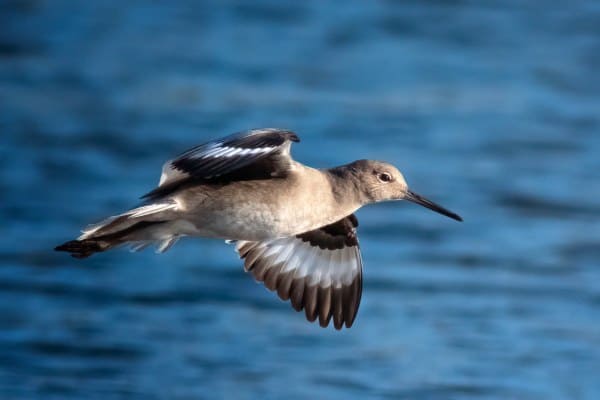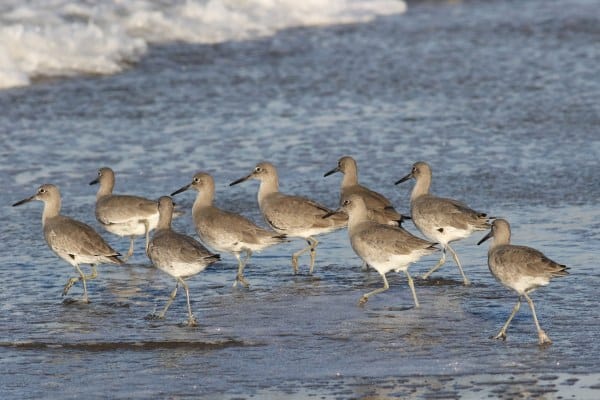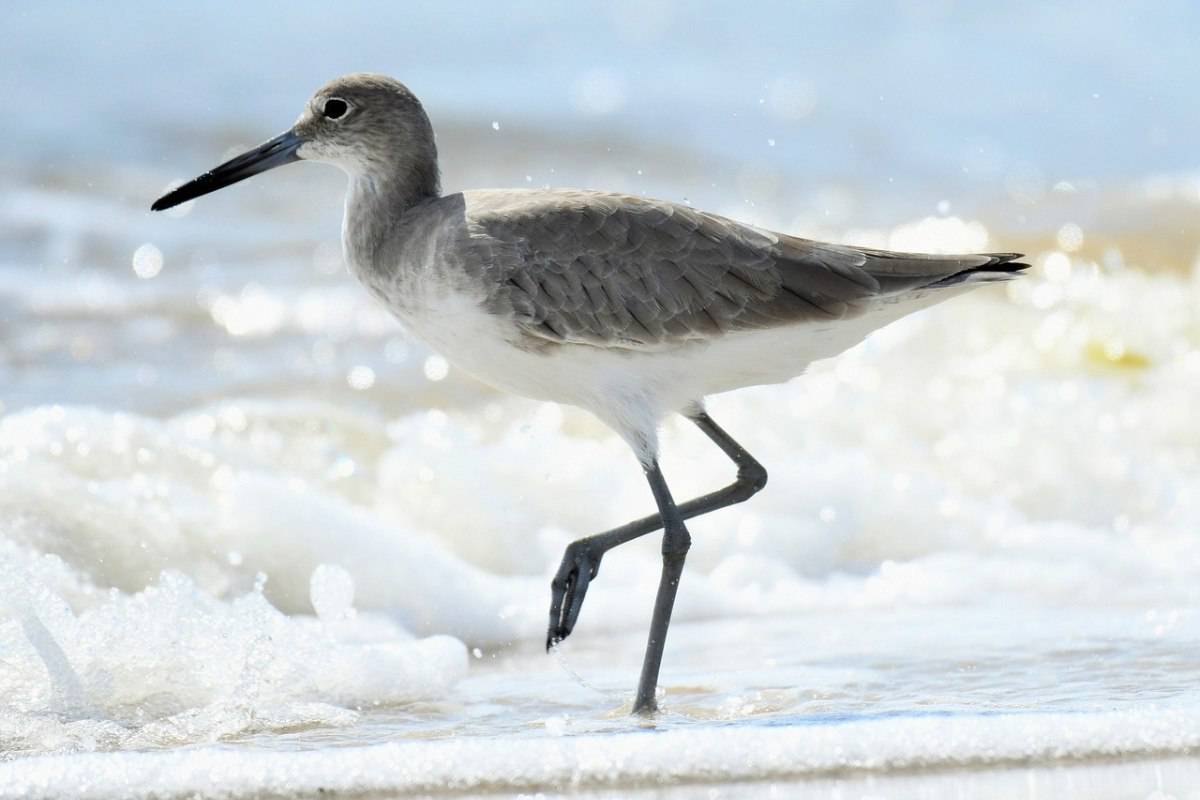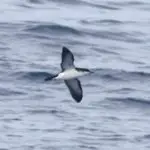Common Name: Willet
Scientific Name: (Tringa semipalmata)| Size | Diet | Range in Hawaii | Status in Hawaii |
|---|---|---|---|
| 14 in. - 16 in. | crabs, worms, mollusks, and shrimp | Oahu, Kauai, Maui, and Big Island | Least Concern |
The Willet, also known as Tringa semipalmata, is a large shorebird species that is native to North and South America. While the species is not native to Hawaii, it has been known to occasionally visit the islands as a non-breeding visitor and vagrant. With its unique appearance and distinctive behavior, the Willet is a fascinating bird species that has captured the attention of birdwatchers and avian enthusiasts around the world.
In this article, we will explore the world of the Willet, its unique characteristics, and its occasional presence in Hawaii.
Willet
Appearance

The Willet is a striking shorebird known for its distinctive appearance. Standing at around 14 to 16 inches (35 to 40 centimeters) tall, it boasts a sleek and elegant profile. Willets have a bold black-and-white striped pattern on their wings, with a white belly and a greyish-brown back.
Their long, straight bill is slender and slightly curved at the tip, perfect for probing in the sand and mud for prey. When in flight, their wings reveal a striking black-and-white pattern, making them easily recognizable along coastal shorelines.
Diet
These birds have a diverse and interesting diet that reflects their adaptability. They primarily feast on a delectable menu of small invertebrates, such as crabs, worms, mollusks, and shrimp, which they deftly snatch from the sand or mud with their slender bills. During migration, they occasionally savor aquatic insects and even small fish, adding a flavorful twist to their coastal dining experience.
Nesting
These shorebirds create their nests in sandy or grassy coastal habitats, often concealed amidst dunes or tall beach grasses. Remarkably, their nests are nothing fancy—just a simple scrape in the sand, skillfully lined with bits of shells, grass, or pebbles.
What’s truly fascinating is their knack for blending in with their surroundings. Willets often choose nesting sites that mimic the colors and textures of the surrounding landscape, making it challenging for predators to spot their nests. They lay a clutch of eggs, usually numbering four, and take turns incubating them.
When it’s time for the chicks to hatch, these fluffy bundles of joy are born ready to explore their sandy playground. As vigilant parents, Willets fiercely defend their young, ensuring their safety as they forage together along the shoreline.
Behavior

Willet’s behavior includes their characteristic probing technique: they gracefully extend their long, slender bills deep into the sand or mud to uncover delectable morsels hidden beneath. Their precision and patience while hunting for aquatic creatures is a testament to their expertise as foragers.
During the breeding season, Willets become vocal performers, filling the air with their distinctive calls that sound like “pill-will-willet.” These calls serve not only as courtship songs but also as territorial markers, helping to establish boundaries.
As devoted parents, Willets are fiercely protective of their nests and chicks. When threatened, they are not afraid to dive-bomb intruders or engage in distraction displays to divert attention away from their young.
Habitat

The Willet is a master of coastal living, and its habitat reflects its remarkable adaptability. These elegant shorebirds are often found in a variety of coastal environments, from sandy beaches and mudflats to salt marshes and estuaries. Willet habitat preferences can be summed up as “where the land meets the sea.
Range
The Willet is a rare visitor to Hawaii. This coastal bird, common in North America, occasionally appears in the Southeastern Hawaiian Islands, including Oahu, Kauai, Maui, and Hawaii Island. These sightings offer a unique opportunity to observe this coastal bird in the Pacific.
Conservation Status
The International Union for Conservation of Nature (IUCN) listed the Willet (Tringa semipalmata) as a species of “Least Concern.” This classification indicated that Willet’s overall population was relatively stable, and it was not facing an immediate risk of extinction.
Interesting Facts
1. Two subspecies
There are two recognized subspecies of Willet: the Western Willet (T. s. inornata) and the Eastern Willet (T. s. semipalmata). They have slightly different plumage and geographic ranges, with the Western Willet being found in the western parts of North America and the Eastern Willet along the Atlantic coast.
2. Taxonomic history
The Willet was historically placed in the genus Catoptrophorus until it was merged with the genus Tringa. This taxonomic change reflects ongoing research and updates in bird classification.
3. Size variations
Willets exhibit sexual dimorphism in size, with males typically being slightly larger than females. This size difference is more noticeable in Eastern Willets.
4. Wingbar variability
The black-and-white wing pattern of Willets can vary among individuals. Some may have more extensive black wing bars, while others exhibit a more muted pattern. This variation can sometimes make bird identification a fun challenge for enthusiasts.
5. Nocturnal nesting
Willets often choose to nest during the night, which can provide some protection for their eggs and chicks from daytime predators.
Frequently Asked Questions
1. Can Willets swim?
While Willets are primarily shorebirds, they are not strong swimmers. They are more adapted to wading and foraging in shallow waters along the shoreline.
2. What is their typical lifespan?
In the wild, Willets can live for approximately 10 to 15 years, although this can vary due to various factors like predation and habitat conditions.
3. Do Willets have any cultural significance?
In some indigenous cultures, Willets may hold cultural significance and be featured in folklore, stories, or art.
4. Can Willets be kept as pets?
No, it is illegal and unethical to keep wild birds like Willets as pets in many countries. They are protected by conservation laws due to their status as migratory birds.
5. Can Willets adapt to urban environments?
While Willets prefer natural coastal habitats, they can occasionally be seen in urban coastal areas. However, human development can pose challenges to their survival due to habitat loss.




